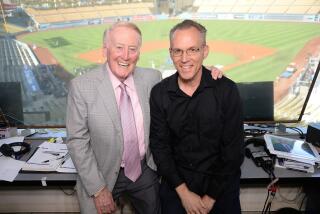Wallach Is His Name . . . and the Wall Is His Aim
- Share via
The late Fresco Thompson, who knew as much about the game as anyone who ever played it or logged it, used to tell me there were two kinds of hitters in baseball, “Those who hit for average--and those who hit for damage.”
The distinction is subtle. A baseball team is made up of those who are meant to score runs--and those who are meant to drive in those runs.
There has never been any question as to which category Timothy Charles Wallach of the Dodgers fits into. Tim has always been a guy who would rather go one for four, the hit a double driving in runs, than three for four with only the decimals showing for the day’s work and the only impact on his average, not the team’s.
There is in baseball an invisible line. It’s called “the Mendoza Line,” after Mario Mendoza, an infielder for Pittsburgh, Seattle and Texas who played nine seasons in the big leagues and batted worse than .200 in five of them.
This is widely held to be the epitome of futility in the big leagues, a standard of failure you almost have to admire for its ineptitude. Mendoza hit only four home runs in his entire career and his slugging average was only minimally higher than his batting average (.200 one season). In his last season, he only got two hits.
In American annals, the name Benedict Arnold stands for traitor, Nathan Hale stands for patriot, Barney Oldfield stands for speed, Charlie Chaplin means comedy. And Mario Mendoza signifies an out. The Great American Out. You didn’t look for him to do much except pop up. He didn’t strike out all that much. Pitchers hated to use three pitches getting him out.
But when Tim Wallach tilted dangerously toward that Mendoza line a couple of years ago and his average moved from .296 to .225 and .223 and .222, no one was unduly alarmed. Wallach was probably one of the most dangerous .225 hitters who ever lived. First of all, he drove in 73 runs with that average one year. He knocked in 62 last year with .222. You will find guys in the lineup with 80 more points of average--but 20 fewer runs batted in and even one guy with 73 more points of average and only 29 RBIs.
In baseball’s record book are marks that stand as milestones for everyone to shoot at. For instance, it lists all players who have 250 or more home runs. There are 103 of them. Wallach isn’t among them. Yet. But he does have 229. Inclusion is very probable before he is through.
The cutoff point for RBIs is 1,200. There are 77 players--out of the thousands who have played this game--who have 1,200 or more runs batted in. Wallach has 1,009.
In slugging average, the cutoff is .400. Only 51 players from Babe Ruth’s .690 to Brooks Robinson’s .401 make it. Wallach is at .355 and has a .510 slugging average this season.
What he never does is merely meet the ball.
“I try to hit it hard some place,” he acknowledges.
He had only one sacrifice bunt last season and that was the first since 1982, when he had the only other five of his career. But he had nine sacrifice flies and led the club in that category last year.
“I don’t say I don’t try to move the runner along from first to third,” he says.
But, basically, he tries to hit the wall with a pitch.
Wallach is batting .276, but he doesn’t look for a run at the batting crown. He leaves that for the choke-up hitters, the walk-getters--he walked only 32 times in his 500-plus plate appearances last season--the bat manipulators.
Strikeouts, of course, are a problem. Wallach goes for some pitches that have a good chance to be wild. But bad-ball hitters are not always regrettable--or regretful. Roberto Clemente bad-balled his way into the Hall of Fame.
A measure of Wallach’s worth to the ballclub is, he has always batted fourth or fifth. He might be the only guy in baseball history ever to bat cleanup when he was hitting .222. He has never batted .300. His high-water mark was .298 in 1987 at Montreal, when he hit 26 homers and drove in 123 runs. He batted .296 in 1990. He has hit more than 20 home runs four times and more than 25 twice.
Managers have a hard job relating to guys who return to the dugout a lot with what the ballplayers call “oh-fers”--zero for a time at bat, or a whole game at bat. But when you divide Wallach’s 1,844 hits--or even his 7,205 at-bats--into his 1,009 runs batted in, you can see he’s a highly-productive batsman, entitled to the odd oh-fer. Wallach can ask management, “Do you want a run--or a decimal point?”
The record book cutoff for two-base-hits is 450. Fifty-three players have more. Wallach is at 392 and climbing.
As Fresco would say, he’s a player who hits for damage. He’s like a fighter with a KO punch and no footwork. He won’t jab you to death, but you make one mistake and they carry you out.
He’s never going to catch Rose or Cobb with their 4,000 hits and 700 doubles. But he has a shot at Rose’s 1,314 RBIs.
Not many players have done as much with 1,844 hits as he has. He’s like a football team that doesn’t get the ball much--but doesn’t need it much. As Satchel Paige would say, “He ain’t restful to pitch to.”
More to Read
Are you a true-blue fan?
Get our Dodgers Dugout newsletter for insights, news and much more.
You may occasionally receive promotional content from the Los Angeles Times.










